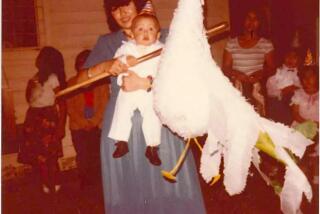Book review: ‘The Memory Palace’ by Bartok
Mira Bartok’s memoir of her schizophrenic, homeless mother, Norma, is relentlessly sad. Unlike memoirs like “Angela’s Ashes” or “The Liar’s Club,” there is very little triumph over tragedy in the author’s life; no forgiveness, no “closure.” There is only this beautifully constructed, richly detailed book. “The Memory Palace” is a creative act that required pure courage and the transformative powers of an artist. Bartok brings a painterly eye to her memories; colorful birds, paintings that mother and daughter both loved, objects in her grandmother’s house that were invested with hope or despair.
When Mira and her older sister received a call in 2006 informing them that Norma, whom they had not seen in 17 years, was dying of stomach cancer, the sisters went to her. They spent their days visiting Norma and going through her storage locker, full of journals, photographs, childhood drawings, toys; bits and pieces of her chopped-up life lived, for many years, on the street. Reading her mother’s journals, Mira was able to remember the talented piano player her mother once was, the imaginative writer, the autodidact, the survivor.
For 47 of her 51 years, Bartok struggled to free herself of her mother. Mira’s father left when she was four and was not seen again. As girls, Mira and her sister Rachelwould push a heavy dresser in front of their bedroom door to prevent their mother from attacking them; as young adults, they ran away from home several times; as adults, they changed their names to prevent their mother from appearing at their homes and workplaces. While attempting to prevent Mira and Rachel from leaving the house one day, their mother broke a bottle and stabbed Mira in the throat. She also stabbed the girls’ grandmothersix times in the back (but did not kill her). Norma also heard voices, attempted and threatened suicide several times, interrogated the girls about sex and boyfriends, believed Nazis were stealing their wombs -- the list goes on and on and on.
Where were the healthcare professionals? The police? Social services?
In the decades since the 1960s, if a person could write their name, sign and cash their disability checks, Bartok reports, it was extremely difficult to get treatment and long-term care.
Their mother would be hospitalized and put back on the streets in days or even hours, drugged into acquiescence with Haldol and Thorazine. With some help from their grandmother and their violent, alcoholic grandfather, the girls were able to survive, attend school and escape to college. But the letters and phone calls found them.
Mira moved to Italy and did not give her mother her address. With distance, she was able to think more clearly about her mother, to construct a memory palace of rooms in which she stored the mysteries of her childhood, returning to the rooms to fill in details and incorporate new understanding of her mother’s struggles. But she could not forgive her.
Violence and instability trailed Bartok into new phases of her life; she married a poet whose moods became overwhelming; on a trip to Israel she wasthreatened by an amorous, gun -toting soldier; on a Fulbright scholarship in Lapland she lived in an apartment below the violent, alcoholic mother of small children; on her return to the United States, she was hit by a truck and suffered severe brain trauma.
The assault on Bartok’s efforts to lead a quiet life is disturbing. One hopes, but cannot be certain, that finally, after their mother’s death, the two sisters have finally found some peace.
“Someday,” Bartok writes, “I will live in a quiet green place, off a winding country road. My house will be small but warm, and the rooms awash with light. The floor will be terra-cotta red.” “The Memory Palace” is proof that the author has been constructing that safe place, if only in her imagination, for her entire life.
Salter Reynolds is a Los Angeles writer.
More to Read
Sign up for our Book Club newsletter
Get the latest news, events and more from the Los Angeles Times Book Club, and help us get L.A. reading and talking.
You may occasionally receive promotional content from the Los Angeles Times.








